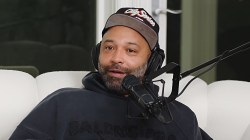After recording collaborative albums with Betty Wright and John Legend, earning a reputation for legendary live shows, and winning multiple Grammy Awards, The Roots have become elder statesmen of the rap game while cementing their legacy as a premier American band. When they’re not recording a new album or touring, in their free time they play house band for The Tonight Show Starring Jimmy Fallon, a role they’ve held since 2009. Their presence as a group is so dominant that it is easy to overlook the group members’ impressive individual accomplishments, which include Black Thought and Questlove’s recent work on the Hamilton cast album. For The Roots, their relentless touring schedule over the past 20-plus years has no doubt played a critical role in their popularity and current status. But when looking at their records and trying to identify a moment of transition from little-known rap band to primetime TV mainstays, that transformation started in 1996. Though their first two albums Organix and Do You Want More?!!!??! were well received, it was 1996’s Illadelph Halflife that acted as a watershed moment for the group and sent them on their current course.
Revisiting Illadelph Halflife: A 20-Year Retrospective
The Roots watershed moment came during a prolonged moment of crisis for rap music. 2Pac had just been murdered and Biggie’s murder was soon to follow. While the Bad Boy-endorsed Shiny Suit Era wasn’t at its peak yet, it was starting to become a dominant sound within rap. In addition to the anger, sadness, and tension in the industry, The Roots’ sound wasn’t fully-formed and familiar to the general public in 1996. In addition to less-than-ideal industry conditions and a consumer base largely unfamiliar with their style, The Roots were signed as the lone rap act on DGC records. Undaunted, they went about creating a defining moment in music. Their challenge would be maintaining the fans they’d gained through the heavy jazz influence of Do You Want More?!!!??! while making an album that would win over more traditional mid-90s East Coast rap fans.
“I hate gettin’ locked up cause that upstate bus reminds me of the slave ships. But then the bible never saved shit. I guess that’s why every juvenile is in the same predicament.” — Mars Co-op

AD LOADING...
The Roots immediately set out to explore new sonic territory with their beats and lyrics in efforts to broaden their fan base. Although Illadelph would see a reduced role from keyboard player and pianist Scott Storch as he sought new solo opportunities, the group honed their production technique by changing up their sound and combining samples with live instrumentation on select songs. They also used their talented lineup of two beatboxers (Rahzel and Scratch), a drummer (Questlove), keyboards (Kamal Gray), and bass (Leonard “Hub” Hubbard) to create instrumentals in the same vein as their sample-based influences. Achieving perfect balance for a rap album with live musicians can be difficult, so The Roots enlisted the help of some trusted collaborators.
To achieve the right balance, The Roots had engineer and producer Kenyatta “Kelo” Saunders at the helm as well as the legendary Bob “Bob Power You There?” Power mixing the album down. Power is a long-respected behind-the-scenes studio expert whose credits include work with A Tribe Called Quest, Common, and De La Soul. Questlove has credited Kelo Saunders in the past for helping them achieve their sound, calling him a “scientist” and a “human Pro Tools machine.”
Photo: Google+/Kenyatta Saunders
Master of the Mix:: From The Roots to Jay Z to Eminem, this Grand Wizzard has been instrumental in making instruments sound better.
In addition to The Roots, Saunders has also worked with folks like Eminem and Jay Z. According to Quest, Kelo keeps “files of every snare i ever hit since i got a deal” and was instrumental in helping them sound “bigger” and perfecting of their live sound. The “bigger” sound is evident throughout, as the album sounds ready-made to both bump in your car and appreciate the musical subtitles while listening at home.

AD LOADING...
“At first, I’m like ‘nah,’ I’m nonchalant from afar, then strike to cut the fake rap star jugular.” – Black Thought
Besides sounding “bigger” than their previous work, Illadelph is also notable for darker, grittier production than Do You Want More?!!!??! Even the transition in cover art from the Blue Note-influencedDo You Want More?!!!??! to the more traditional mid-90s Hip Hop aesthetic of Illadelph signaled the ushering in of a new era. The album’s most popular single, “Clones,” is a dark, menacing beat that offers up that punched-in-the-face-feeling. The song’s chorus is a haunting, sultry female vocal sample instead of a rapped, sung, or scratched hook. The use of an unexpected element for their chorus is reminiscent of the Geto Boys “Mind Playing Tricks on Me.” One of the album’s other signature sample/live instrumentation mixes “Concerto of a Desperado” may not have the same level of menace as “Clones,” but it remains a somber tune. Cello, female vocals, and vintage soundtrack samples come together in an eerie mix of perfection. This downcast vibe is found throughout on songs like “It Just Don’t Stop,” “Section,” and “UNIverse at War,” making it one of the most intense records in the group’s catalogue. While this sound was a noticeable departure from their previous album, fans of their earlier work could also find solace in lighter, jazzier songs like “What They Do,” which resulted in instantaneous Greatest Hits material.
During an interview with LA Times after the release of em>Do You Want More?!!!??! Questlove said, “The key to getting people open to The Roots is time. All they need is 72 minutes of undivided attention.” Quest may have been talking about their previous album, but the same sentiment holds true for Illadelph. Beyond the varied and layered production, The Roots’ third album brought lyrics of equal strength that are worthy of many repeat listens. There is also an increased aggressiveness and edge to the lyrics. Black Thought wasted no time in letting people know he wasn’t fucking around, rapping “At first, I’m like “nah”, I’m nonchalant from afar, then strike to cut the fake rap star jugular” on the album’s third song, “Section.” On “Clones,” Mars Co-op drops a scene-stealing verse to open the track and may deserve kudos for having the most memorable verse on the album with lines like, “I hate gettin’ locked up cause that upstate bus reminds me of the slave ships. But then the bible never saved shit. I guess that’s why every juvenile is in the same predicament.”
“Clones” is a dark, menacing beat that offers up that punched-in-the-face-feeling.
The increased intensity isn’t over the top though, and Black Thought is reflective and thoughtful throughout. In addition to taking on corny MCs, the album tackles broader social issues in the world and problems taking place in the group’s backyard. On “Panic!!!!!,” the incomparable Tariq Trotter laments the shooting of young man in his neighborhood, someone who he had warned about the dangers of street life. Thought raps, “I take a step out the spot, to the point of attack, and see the shorty wop heart blast out his back. Damn, I’m thinkin’ it don’t cease, it’s no more peace. Police level increase, but what the fuck, it’s still crime on the streets.” Looking back on the album 20 years later, these lyrics seem to anchor more relevance more than ever. The group’s keen eye for social commentary on a local and global level remains evident throughout.

AD LOADING...
Another element that set Illadelph Halflife apart from its predecessor is the impressive guest list. In addition to stellar verses from Black Thought and one-time group members Dice Raw and Malik B, the album saw The Roots chart new waters with well-known cameos from Common and Q-Tip. The Abstract brought his A-game to “Ital” while Common and Thought have such incredible chemistry, it’s no wonder they were once rumored to have a group with Absolute and Pharoahe Monch. In addition to the beefed-up arsenal of MCs, The Roots further bolstered their sound with several impressive jazz and soul reinforcements. D’Angelo, who had just released his soon-to-be platinum debut Brown Sugar, and Raphael Saadiq added their soulful croonings to “The Hypnotic” and “What They Do.” “One Shine” features the talents of Joshua Redman on sax and vocals from Grammy Award-winner Cassandra Wilson.
“Offbeat rhythms, unorthodox chords, stacks of harmony, an overall rebellious attitude towards the status quo.” – Questlove describing the Soulquarians
The groups’ work with Common, D’Angelo, and Q-Tip also marked the early beginnings of the Soulquarians. The artist collective included the aforementioned artists as well as Bilal, Erykah Badu, J Dilla, James Poyser, Mos Def, Pino Palladino, Questlove, and Talib Kweli. According to Questlove’s recollection, the group started to come together in the spring of 1996, just before the release of Illadelph. Group members had an intimate relationship with Jimi Hendrix’s Electric Lady Studios and did the majority of their recording there. Their fingerprints are all over Common’s critically acclaimed Like Water For Chocolate, D’Angelo’s Grammy Award-winning Voodoo, and several other seminal albums from the late 90s and early 2000s.

AD LOADING...
In an interview with Vibe magazine, Questlove said the Soulquarians relished a “sickness in our work — offbeat rhythms, unorthodox chords, stacks of harmony, an overall rebellious attitude towards the status quo.” While the group’s efforts together did generate their fair share of beloved albums, their rebellion against the status quo was sometimes confusing to fans, as was seen with the mixed reception of Common’s Electric Circus. Regardless of people’s sometimes mixed feelings towards the collective’s later work, Electric Lady became a creative hotbed for like-minded artists who shared The Roots’ aesthetic. “That place was like a clubhouse,” Questlove said of the studio. “You’d go even if you didn’t have a session, just hopin’ somethin’ would come up.” The Roots involvement with the Soulquarians would have a significant influence on their Illadelph Halflife, Things Fall Apart, and Phrenology albums and help them gain new listeners through Questlove and James Poyser’s involvement in other albums.
Former HipHopDX Social Media Director, head of marketing for BET’s One Shot TV show and Philadelphia native Mike Trampe recalls the impact of Illadelph Halflife on himself and much of Philly’s youth population in 1996.
“At the time when [it came out], I was in 8th grade, and I remember just having my cassette tape and just listening to it on the bus to school, Trampe tells DX via phone call. “I remember it had the ‘215’ side and the ‘610’ side, which are the Philly area codes. Those guys just brought MCing on top of bringing that soulful and jazz stuff in Hip Hop. That it was like the greatest album to me ever. And then they made that video just clowning the industry (Laughs). That’s the type of stuff they would do. They would make a type of song clowning what the industry is and what was abusing Hip Hop, lying. They never got involved in the East-West beef thing, and that’s not to say they’re not street dudes. But I just think they’re smart guys, and they just make good music. They don’t need anything else for them to push sales.”
An accurate summarization. The varied production and fierce lyricism on Illadelph Halflife create a rewarding and perhaps challenging listen. The album marks a transitional phase from the group and a willingness to set high expectations for their listeners. While the group seemed to be aware they were heading into new territory, perhaps at the time even they didn’t understand what direction they were ultimately headed in. With total transparency, they close the album out by saying, “For now The Roots remain a little bit of an enigma, even to themselves.” Their final destination may have been a mystery at the time, but it doesn’t really matter. The Roots third album is indeed “one of the year’s best rap offerings,” as best-selling author and then New York Times journalist Neil Strauss wrote at the time.

AD LOADING...
It put them on their course to become one of rap music’s greatest groups and holds up very well by today’s standards. Whether it will be a revisit or your first listen, do yourself a favor and play Illadelph Halflife today.
Dana Scott contributed to this article.



